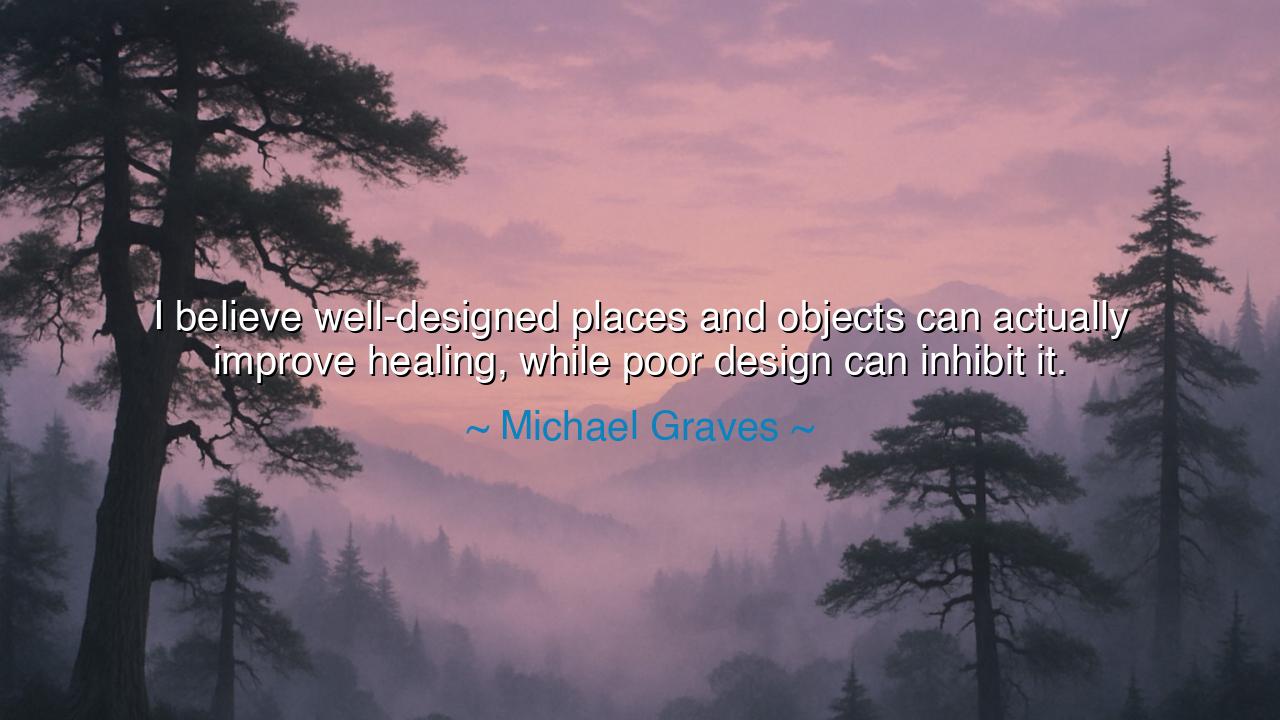
I believe well-designed places and objects can actually improve
I believe well-designed places and objects can actually improve healing, while poor design can inhibit it.






“I believe well-designed places and objects can actually improve healing, while poor design can inhibit it,” spoke Michael Graves, the architect who transformed both the skyline and the soul of design. His words carry not the cold logic of geometry, but the living warmth of compassion. For he spoke not merely of buildings and objects, but of the power of form to touch the human spirit, of how the spaces we inhabit and the tools we use shape the rhythm of our bodies, our emotions, and our will to live. His insight arose not from theory alone, but from the crucible of personal suffering—a truth he learned through pain, and one that he shared as a sacred lesson for generations to come.
Michael Graves, once known for his bold and playful architecture, became in later life a teacher of deeper wisdom. After an illness left him paralyzed from the chest down, he found himself in the sterile, indifferent halls of hospitals—spaces built for function but not for humanity. The instruments that surrounded him were useful, but cruelly impersonal. Their design ignored the dignity of the patient, as if the sick were machines to be repaired rather than souls in need of care. It was then that Graves realized that design is not neutral—that it has the power to heal or to harm, to uplift or to oppress. From his wheelchair, he began to reimagine the world not as a distant architect, but as a man rediscovering how design could restore life’s grace.
His quote speaks, therefore, to a universal law: that beauty and function are not opposites but allies in healing. The ancients knew this truth well. In the temples of Asclepius, the Greek god of medicine, patients were treated not only with herbs and incantations, but within spaces designed to calm the spirit—open courtyards filled with sunlight, gentle fountains, and fragrant gardens. They understood that the soul must be comforted for the body to recover. Likewise, in the monasteries of medieval Europe, infirmaries were built with vaulted ceilings and stained glass—not out of luxury, but because the play of light and color reminded the suffering of divine presence. Through design, they sought to heal not only flesh, but faith.
Graves’ insight returns us to that sacred harmony. He reminds us that healing is a human experience, not merely a medical one. The patient must feel seen, the environment must whisper comfort, and the tools of care must embody empathy. A hospital designed without warmth becomes a place of quiet despair, while one crafted with attention to light, proportion, and texture becomes an ally in recovery. So too, in our daily lives, the homes we inhabit and the objects we touch either nourish us or drain us. A chair can embrace or alienate; a room can inspire calm or chaos. In every design lies a moral choice—whether to serve the human spirit or to ignore it.
There is a story told of Florence Nightingale, the “Lady with the Lamp,” who revolutionized not only nursing but hospital design itself. She observed that the wounded in dark, airless wards perished more often than those in clean, sunlit ones. Her conclusion was both simple and profound: that light, order, and cleanliness were as vital to healing as medicine. She became, in essence, a designer of healing spaces, proving that architecture, too, could be an instrument of mercy. Graves’ wisdom echoes hers across time: that good design is not a luxury—it is an act of love, an offering to the well-being of humanity.
Yet his warning is equally powerful: poor design can inhibit healing. A space without thought becomes an obstacle, a tool without empathy becomes a barrier. The sick, the elderly, the weary—those most in need of care—suffer not only from their conditions, but from the coldness of the environments we build around them. How often do we design without heart, building faster and cheaper, forgetting that every wall, every curve, every handle speaks to someone’s spirit? Graves calls us to awaken from this numbness, to see design as a moral responsibility—for in every creation, we shape not only function but feeling.
The lesson, then, is both practical and profound: create with compassion. Whether you are an architect, a craftsman, a nurse, or simply one who tends to a home, design the spaces of your life with the intent to nurture the human soul. Let your surroundings breathe light and hope. Let beauty become a form of medicine, and empathy a material as essential as stone or steel. For when we honor humanity through design, we do more than build structures—we build sanctuaries of healing.
So remember the words of Michael Graves: design is not decoration—it is destiny. To design with care is to heal; to design without it is to wound. And when the day comes that every room, every tool, every public space reflects the dignity of those who dwell within it, then perhaps the world itself will begin to recover—not only in body, but in spirit. For the truest design, as Graves reminds us, is the art of making life itself more humane.






AAdministratorAdministrator
Welcome, honored guests. Please leave a comment, we will respond soon